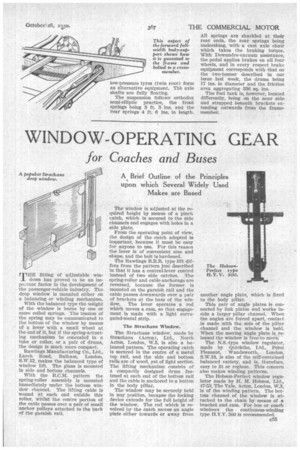WINDOW-OPERATING GEAR
Page 113

If you've noticed an error in this article please click here to report it so we can fix it.
for Coaches and Buses
A Brief Outline of the Principles upon which Several Widely Used Makes are Based
MHE fitting of adjustable win dows has proved to be an impo2tant factor in the development of the passenger-vehicle industry. The drop window is mounted either on a balancing or winding mechanism.
With the balanced type the weight of the window is borne by one or more coiled springs. The tension of the spring may be communicated to the bottom of the window by means of a lever with a small wheel at the end of it, but if the spring-actuating mechanism be concealed in a tube or roller, or a pair of drums, the design is much more compact.
Rawlings Manufacturing Co., Ltd., Larch Road, Balham, London, s.w.n, makes the balanced type of window lift. The glass is mounted in side and bottom channels.
With the B.C.M. pattern the spring-roller assembly is mounted immediately under the bottom window channel. The lifting cable is wound at each end outside this roller, whilst the centre portion of the cable passes over a pair of small anchor pulleys attached to the back of the garnish rail.
The window is adjusted at the required height by means of a pinch catch, which is secured to the side channels and engages with holes in a side plate.
From the operating point of view, the design of the catch adopted is important, because it must be easy for anyone to use. For this reason the lever is of convenient size and shape, and the bolt is hardened.
The Rawlings B.R.R. type lift differs from the pattern just described in that it has a central-lever control instead of two side catches. The spring-roller and cable anchorage are reversed, because the former is mounted on the garnish rail and the cable passes downwards over a pair of brackets at the base of the window. The lever operates a rod which moves a cam, so that engagetnent is made with a light corrugated-metal strip.
The Strachans Window.
The Strachans window, made by Strachans (Acton), Ltd., 'North Acton, London, W.3, is also a balanced pattern. The operating catch is secured in the centre of a metal top rail, and the side and bottom rails are of wood, yet of light section. The lifting mechanism consists of a compactly designed drum fastened at each end of the bottom rail and the cable is anchored to a button in the body pillar.
The window may be securely held in any position, became the locking device extends for the full height of the window. The rod which is revolved by the catch moves an angle plate either towards or away from another angle plate, which is fixed to the body pillar.
This pair of angle plates is connected by link plates and works inside a larger-pillar channel. When the angles are forced apart, contact is made with the side of the pillar channel and the window is held. When the moving angle plate is released the window is free to move.
The N.S.-type window regulator, made by Quicktho, Ltd., Point Pleasant, Wandsworth, London, S.W.18, is also of the self-contained balanced variety, and is, therefore, easy to fit or reglaze. This concern also makes winding patterns.
The Hobson-Perfect window regulator made by H. M. Hobson, Ltd., 47-55, The Vale, Acton, London, W.3, is of the winding pattern. The bottom channel of the window is attached to the chain by means of a bracket and cam. For bus or coach windows the continuous-winding type H.Y.V. 500 is recommended.




















































































































































































